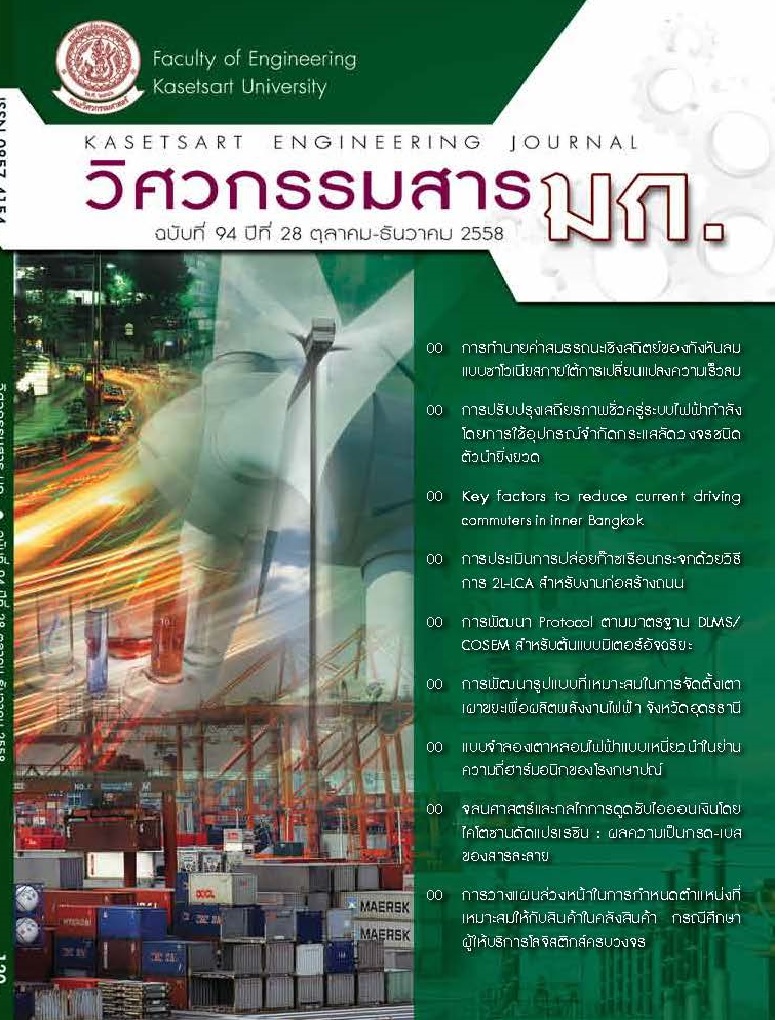การทำนายค่าสมรรถนะเชิงสถิตย์ของกังหันลมแบบซาโวเนียสภายใต้การเปลี่ยนแปลงความเร็วลม
Keywords:
กังหันลมแบบซาโวเนียส, สมรรถนะ, พลศาสตร์ของไหลเชิงคำนวณ, อากาศพลศาสตร์, Savonius wind turbine, performance, computational fluid dynamics, aerodynamicsAbstract
งานวิจัยนี้นำเสนอการทำนายค่าสมรรถนะเชิงสถิตย์ของกังหันลมแบบซาโวเนียสที่อยู่ในตำแหน่ง 0°, 30°, 60°, 90°, 120°, และ 150° ที่ความเร็วลมเท่ากับ 7, 17.5 และ 32.78 เมตรต่อวินาที โดยการใช้โปรแกรมสำเร็จรูปทางด้านพลศาสตร์ของไหลเชิงคำนวณ Fluent การศึกษาจะอยู่ในรูปแบบ 2 มิติด้วยการใช้ตาข่ายข้อมูลแบบสามเหลี่ยม จากการเปรียบเทียบกับผลการทดลองพบว่าแบบจำลองความปั่นป่วนแบบ k-ε RNG มีความแม่นยำสูงกว่า Standardk-ε และ k-εrealizable ดังนั้นงานวิจัยนี้จึงเลือกใช้แบบจำลอง k-ε RNG จากผลการวิเคราะห์พบว่าการไหลวนของอากาศแบบสลับที่เกิดขึ้นที่ด้านหลังของใบพัดที่อยู่ในตำแหน่ง 0°, 30°, และ 150° ก่อให้เกิดการกวัดแกว่งของความดันของอากาศรอบใบพัด ซึ่งสามารถนำไปสู่การสั่นสะเทือน และความเสียหายของกังหันลมได้ ยิ่งไปกว่านั้นที่ตำแหน่งของใบพัดเท่ากับ 30° ค่าสัมประสิทธิ์แรงต้านอากาศในทิศทางตามและขวางการไหลมีค่าสูงสุดเท่ากับ 1.94 และ -1.83 ขณะที่ค่าสัมประสิทธิ์แรงบิดสูงสุดเท่ากับ 0.68 จะพบเมอื่ กังหันลมอยู่ในตำแหน่ง 120° ซึ่งผลการวิเคราะห์ที่ได้มาจะเป็นตัวแปรสำคัญที่ใช้ในการออกแบบกังหันลมแบบซาโวเนียสต่อไป
Prediction of Static Performance of Savonius Wind Turbine under the Variation of Wind Velocities
This paper presents the prediction of the static performance of Savonius wind turbine at the position of 0°, 30°, 60°, 90°, 120°, and 150° under the wind speed of 7, 17.5, and 32.78 m/s using the commercial Computational Fluid Dynamics (CFD) program, Fluent. The study was conducted in a 2D domain with the triangular mesh element. By comparing with the experimental results, the k-ε RNG turbulence model provides a more accurate prediction above the standard k-εand the k-εrealizable so it was employed through the study. The numerical results showed that the vortex shedding, occurring at the downstream of the turbine at 0°, 30°, and 150° causes the pressure fluctuation on the turbine surface. These can lead to the vibration and the failure of wind turbine. Moreover, at the rotor angle of 30 °, the highest drag coefficient in streamwise and spanwise directions is 1.94 and -1.83, respectively. Meanwhile, the highest torque coefficient of 0.68 appears at the rotor angle of 120°. These obtained results will be used as the necessary parameters in order to design the Savonius wind turbine.


